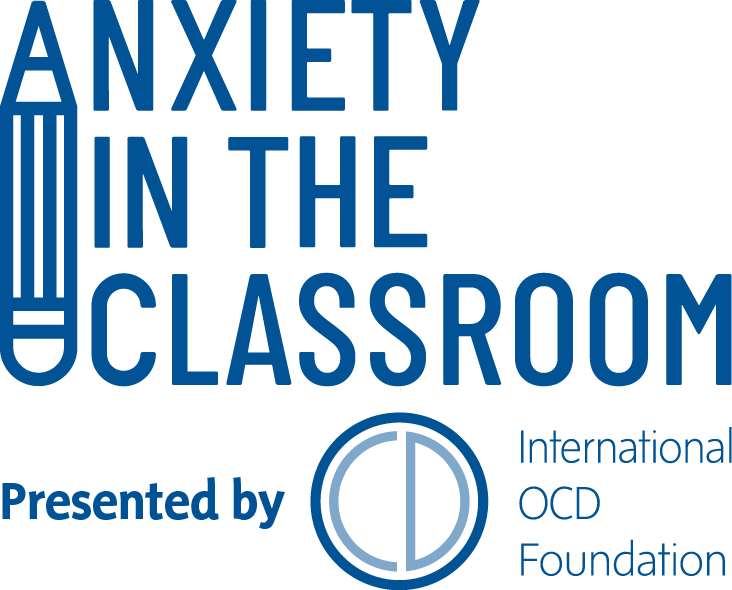How to Talk to Your Students
When you recognize that a student may be exhibiting symptoms of anxiety and/or OCD, it's important that you take the time to speak to them. However, knowing what to say, and how to address your concerns is not always easy. This page contains information to help guide you when talking to a student about anxiety and/or OCD.
How do you talk to a student that you suspect may have anxiety and/or OCD?
In this video, Aureen Wagner, PhD, talks about how you can go about explaining anxiety to a student, and how you can help them to identify if they are experiencing excessive anxiety.
Read below for additional information tips for talking to a student about anxiety and/or OCD.
Tips for Talking to Students with Anxiety and/or OCD
Below are some tips and guidelines to keep in mind when talking to your students about their anxiety/OCD.
1. Take their concerns seriously
Anxiety is a normal emotion that everyone experiences from time to time, but severe anxiety can be debilitating, and may meet the clinical criteria to be considered a disorder. Up to 25%1Costello E., Egger H., Angold A. 10-year research update review: the epidemiology of child and adolescent psychiatric disorders: I. Methods and public health burden. J Am Acad Child Adol Psychiatry.2005;44:972–986. [PubMed] of students in your classroom may be experiencing anxiety at a level to be diagnosed with an anxiety disorder. Anxious students often feel embarrassed or ashamed about their difficulties, and it takes courage for them to discuss their fears with you, regardless of their age. When they do, it is important to take their concerns seriously. Do not label them as “silly” or accuse your student of making an excuse for perceived shortcomings.
2. Offer validation and acceptance
Validating someone’s fear isn’t the same as agreeing that their fear is true. It is an acknowledgment that their feelings are understandable, and you accept them. For example, you might say, “If I thought my mother would die if I didn’t say my prayers 20 times, then I would have a hard time concentrating in class, too.” Offering validation and acceptance are powerful ways to build a positive and trusting relationship between a teacher and their student.
3. Avoid shaming
Eliciting shame is an unhelpful and unproductive way of giving feedback. Instead of getting a person to change their behavior, it usually simply shuts them down. A student who has been shamed, whether intentionally or unintentionally, will feel humiliated, angry, and worthless, and may exhibit behaviors that are even more challenging to manage in the classroom. Examples of shaming statements are: “Why would you do that?” or “What is the matter with you?” or “You are acting crazy!”
4. Do not “call out” your student in front of the entire class
Anxious students don’t want to be the center of attention for any reason, especially if they are in the throes of an anxiety attack. If your student is fidgeting, isolating, late to school, or avoiding touching things or participating in class discussions, it is best to address your concerns privately instead of in front of the entire class. During the meeting, ask the student about their fears, what coping strategies they find to be most effective, and how you might be helpful. Develop specific statements to use when supporting your student in a triggering moment.
5. Encourage your student to tell you if they are struggling
Sometimes students are reluctant to seek out help from their teachers or other school personnel because they perceive this as being a bother or fear being annoying, or they just don’t know what to say. To prevent this, explain that you would like to know if your student is struggling, in order to prevent the situation from escalating. Here are some ways to increase the likelihood that your student will engage with you:
- Set up a regularly scheduled check-in (for example, every Tuesday)
- Agree upon a specific time of day (for example, before school starts) for a student to contact you
- Agree upon the method by which the student can contact you (a hand-written note, or an email)
6. Develop a game plan with your student
Work to construct a plan to use when their anxiety is triggered. Be sure to document this plan and share it with other teachers and your student’s parent(s)/caregiver(s). Finally, after using the plan several times, meet with the student to review its effectiveness and adjust as necessary.
The plan might include:
- A specific cue or signal to use to communicate that the plan is going to be implemented
- The use of fidget toys or movement breaks
- A designated quiet space for a time out
- Coping strategies such as deep breathing, mindfulness, or cognitive restructuring exercises
7. Be mindful of how you communicate
Respond positively to a personal style that is consistent, firm, and kind. When interacting with a student who is anxious, it is best to be calm, clear, and directive. For example, you might say, “Come with me and sit here. Let’s do a deep breathing exercise.”
How to Talk to Parent(s)/Caregiver(s)
If you notice that a student is exhibiting symptoms of anxiety or OCD, it is important to talk to their parent(s)/caregiver(s). Learn how to talk to parents and caregivers.



